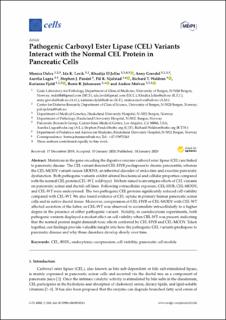Pathogenic Carboxyl Ester Lipase (CEL) Variants Interact with the Normal CEL Protein in Pancreatic Cells
Valvatne, Monica Dalva; el Jellas, Khadija; Gravdal, Anny; Njølstad, Pål Rasmus; Molven, Anders; Fjeld, Karianne; Lugea, Aurelia; Pandol, Stephen J; Waldron, Richard T; Lavik, Ida; Johansson, Bente B.
Journal article, Peer reviewed
Published version

Åpne
Permanent lenke
https://hdl.handle.net/11250/2762731Utgivelsesdato
2020Metadata
Vis full innførselSamlinger
- Department of Clinical Medicine [2066]
- Registrations from Cristin [9791]
Sammendrag
Mutations in the gene encoding the digestive enzyme carboxyl ester lipase (CEL) are linked to pancreatic disease. The CEL variant denoted CEL-HYB predisposes to chronic pancreatitis, whereas the CEL-MODY variant causes MODY8, an inherited disorder of endocrine and exocrine pancreatic dysfunction. Both pathogenic variants exhibit altered biochemical and cellular properties compared with the normal CEL protein (CEL-WT, wild type). We here aimed to investigate effects of CEL variants on pancreatic acinar and ductal cell lines. Following extracellular exposure, CEL-HYB, CEL-MODY, and CEL-WT were endocytosed. The two pathogenic CEL proteins significantly reduced cell viability compared with CEL-WT. We also found evidence of CEL uptake in primary human pancreatic acinar cells and in native ductal tissue. Moreover, coexpression of CEL-HYB or CEL-MODY with CEL-WT affected secretion of the latter, as CEL-WT was observed to accumulate intracellularly to a higher degree in the presence of either pathogenic variant. Notably, in coendocytosis experiments, both pathogenic variants displayed a modest effect on cell viability when CEL-WT was present, indicating that the normal protein might diminish toxic effects conferred by CEL-HYB and CEL-MODY. Taken together, our findings provide valuable insight into how the pathogenic CEL variants predispose to pancreatic disease and why these disorders develop slowly over time.
